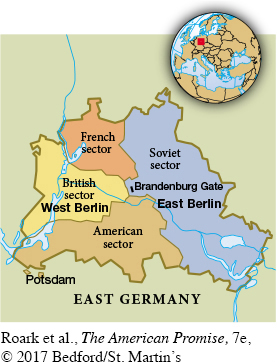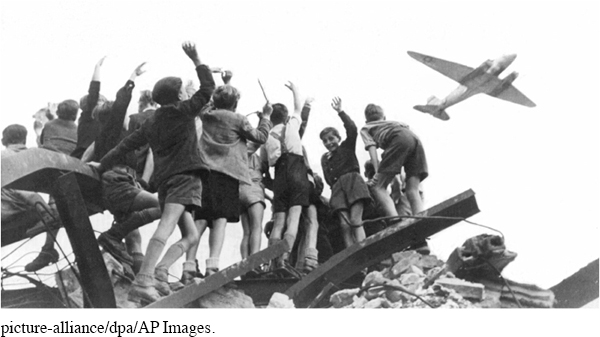The American Promise: Printed Page 749
The American Promise, Value Edition: Printed Page 681
The American Promise: A Concise History: Printed Page 777
The Truman Doctrine and the Marshall Plan
The American Promise: Printed Page 749
The American Promise, Value Edition: Printed Page 681
The American Promise: A Concise History: Printed Page 777
Page 749In 1947, the United States began to implement the doctrine of containment that would guide foreign policy for the next four decades. It was not an easy transition; Americans approved of taking a hard line against the Soviet Union but wanted to keep their soldiers and tax dollars at home. In addition to selling containment to the public, Truman had to gain the support of a Republican-
Crises in two Mediterranean countries triggered the implementation of containment. In February 1947, Britain informed the United States that its crippled economy could no longer sustain military assistance to Greece, where the autocratic government faced economic disaster and a leftist uprising, and to Turkey, which was trying to resist Soviet pressures. Unaware that the Soviet Union had deliberately avoided aiding the Greek Communists, Truman promptly sought congressional authority to send both countries military and economic aid. Meeting with congressional leaders, Undersecretary of State Dean Acheson predicted that if Greece and Turkey fell, communism would soon consume three-
Truman did just that. He warned that if Greece fell to the rebels, “confusion and disorder might well spread throughout the entire Middle East” and then create instability in Europe. According to what came to be called the Truman Doctrine, the United States must not only resist Soviet military power but also “support free peoples who are resisting attempted subjugation by armed minorities or by outside pressures.” The president failed to convince Helen Gahagan Douglas and some of her congressional colleagues, who wanted the United States to work through the United Nations and opposed propping up the authoritarian Greek government. But the administration won the day, setting a precedent for forty years of Cold War interventions that would aid any kind of government if the only alternative appeared to be communism.
The American Promise: Printed Page 749
The American Promise, Value Edition: Printed Page 681
The American Promise: A Concise History: Printed Page 777
Page 751A much larger assistance program for Europe followed aid to Greece and Turkey. In May 1947, Acheson described a war-
The American Promise: Printed Page 749
The American Promise, Value Edition: Printed Page 681
The American Promise: A Concise History: Printed Page 777
Page 752
In March 1948, Congress approved such assistance, which came to be called the Marshall Plan, after Secretary of State George C. Marshall, who proposed what a British official called “a lifeline to a sinking man.” Over the next five years, the United States spent $13 billion ($117 billion in 2010 dollars) to restore the economies of sixteen Western European nations. Marshall invited all European nations and the Soviet Union to cooperate in a request for aid, but the Soviets objected to the American insistence on free trade and financial disclosure. As U.S. officials had expected, the Soviets rejected the offer and ordered their Eastern European satellites to do the same.
Humanitarian impulses as well as the goal of keeping Western Europe free of communism drove the adoption of this enormous aid program. The Marshall Plan also helped boost the U.S. economy; the European recipients used the aid to buy American products, and Europe’s economic recovery created new markets and opportunities for American investment. By insisting that the recipient nations work together, the Marshall Plan marked the first step toward the European Union. (See “Making Historical Arguments: Why Did the United States Launch the European Recovery Program?”)
While Congress was debating the Marshall Plan, in February 1948 the Soviets brutally installed a Communist regime in Czechoslovakia, the last democracy left in Eastern Europe. Next, Stalin threatened Western access to Berlin. That former capital of Germany lay within Soviet-
“We stay in Berlin, period,” Truman vowed. To avoid a confrontation with Soviet troops, for nearly a year U.S. and British pilots airlifted 2.3 million tons of goods to sustain the West Berliners. Stalin hesitated to shoot down these cargo planes, and in 1949 he lifted the blockade. The city was then divided into East Berlin, under Soviet control, and West Berlin, which became part of West Germany.
